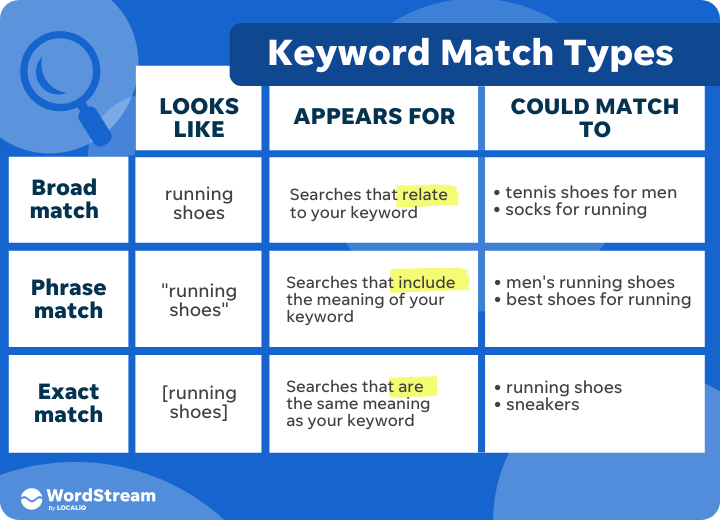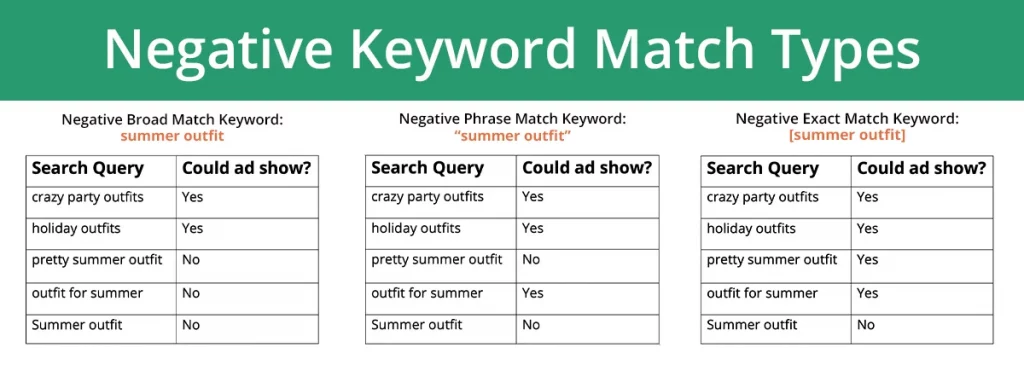Keyword match types in digital advertising, particularly in platforms like Google Ads, define how closely a user’s search query must match your chosen keyword to trigger your ad. When running a Google Ads campaign, being able to chose the correct keyword match type is exceptionally important in order to reach the right audience. Key word match types determine how closely a user’s search query aligns with your selected keywords, in order to trigger your ad. Here you will find the different types of match types, how they work, and how you can utilize them in order to reach your campaigns goal.

1. Exact Match
Exact match provides the highest level of control. Ads are triggered when, and only when, the search query matches your keyword exactly. An exact match keyword has the same meaning or the same intent as the keyword.
| [Keyword] | ✓ | X |
| [Shoes for men] | Shoes men | Mens tennis shoe |
| Men shoes | Shoes for boys | |
| Men shoe | Mens running shoes |
- Exact match is used in campaigns that have a strict budget, and are aiming for the highest relevance.
- Cons of using exact match: would not be able to reach a wide audience when starting off.
2. Phrase Match
A phrase match keyword allows your ads to show when a search includes the meaning of your keyword in the exact order, but can have additional words before or after.
| “Keyword” | ✓ | X |
| “Tennis shoes” | Shoes for tennis | Tennis store |
| Buy tennis shoes on sale | Shop for sneakers | |
| Red tennis shoes |
- Phrase match should be used when you want to target specific user intents while still allowing flexibility.
- This match type is for campaigns focused on medium-level specificity.
- Cons of using phrase match: limited reach compared to broad match.
3. Broad Match
A broad match is the default keyword match type in Google Ads. This match type allows your ads to appear for searches that are related to your keywords, including synonyms, misspelled words, and other relevant contrasts.
| Keyword | ✓ |
| Low-card diet plan | Carb-free foods |
| Low-carb diets | |
| Mediterranean diet book | |
| Carb-free meals |
- Broad match keywords should be used when starting a campaign, and looking to gather data.
- This match type is used to reach a wider audience and explore potential keywords.
- Cons of using broad match is that they might show up in unrelated searches.
4. Negative Match

Negative match types prevent your ads from appearing on specific keywords that are irrelevant to your business.
| Negative Keyword | Searches Blocked |
| Free | Free running shoes |
| Free jogging sneakers |
- Negative keywords are to be used to eliminate irrelevant traffic and reduce wasted ad spend.
Know When to Use the Right Match Type:
- Exact Match: Use for bottom-funnel, conversion-focused campaigns.
- Phrase Match: Use for balancing reach and relevance in mid-funnel campaigns.
- Broad Match: Use for awareness campaigns or when entering a new market.
- Negative Match: Use to refine targeting and avoid wasting your budget.